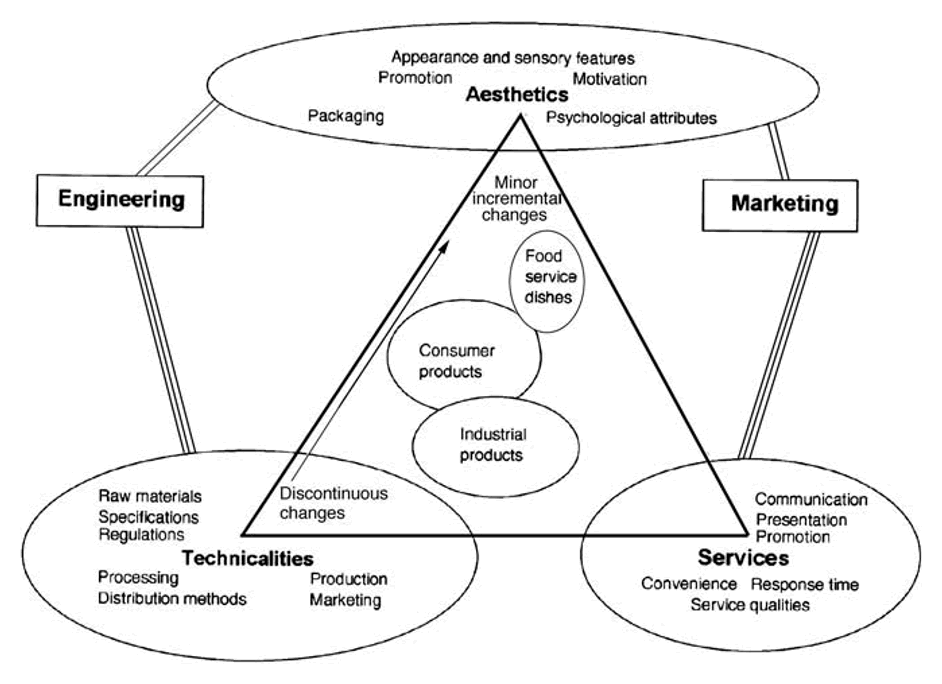FOOD
PRODUCT DEVELOPMENT
Mary Earle, Richard Earle and Allan Anderson |
| Loading
|
going? |
|
||||
|
|
|
Part
2, Chapter 3
The product development process 3.6 Where is the product development process going? The project development process has settled into a well-proven stage pattern with critical reviews at each stage (the Critical PD Process). These reviews give opportunities for careful examination of progress, which if passed leads to the next stage and if not to abandonment or recycling as appropriate. Generally a four-stage PD Process is clear and sufficient, though in some projects substages may be necessary, especially for major innovations taking time for development. The importance of the activities and their sequence within the stages are determined by the level of innovation, the resources available to the company, the timing of the project, the company's risk level, and the knowledge and skills in the company.
One important factor is the degree of novelty, ranging from product improvement to a major product innovation. There can be a standard PD Process with a reduced number of activities for each project where there is:  more or less continuous modification of an existing product line with more or less continuous modification of an existing product line with fairly minor changes to produce variations on products;  processes, equipment and markets are substantially unaltered; and processes, equipment and markets are substantially unaltered; and
 no major shift in structure and organisation of the company's no major shift in structure and organisation of the company's product development. If the company has a data recording and storage system for product development, there may be sufficient knowledge of consumers, markets, products and production to reduce the research in the first stage, and also in the product commercialisation. Even the product launch can be a standard procedure. For these incremental changes in products, there can be a standard PD Process which is steadily improved after the analysis and evaluation at the end of each project. The efficiency and the effectiveness of the product development process can be improved over time. For major discontinuous changes, there is a need for more exploratory activities in the first stage of the PD Process, and also because of the large costs involved there will be more project and business analysis throughout the project. The decisions are major because of the resources needed, and therefore a great deal of knowledge is required which usually has to be created in the project. A consistent, logical process is needed, but it cannot be highly structured because of the unknown nature of the project. The process is usually more exploratory and less customer-driven than the typical incremental product development process. It concentrates in the first stage on recognising the application of developing technologies in new products for the company, so there is an early design of product prototypes before opportunity analysis, assessment of market attractiveness, market research and financial analysis (Veryzer, 1998). Technological research is necessary to identify what is possible, before the consumer can study product ideas and develop product concepts. In the later stages, there is important design of the plant, production and the market strategy, which again needs design ideas, evaluation and then application. Figure 3.22 indicates how new product placement can often be related to the three major components - aesthetics, technicalities and service.  Fig. 3.22 Indicative influences affecting activities choice in the PD Process. ( - click to enlarge) Key: Strength of relationships: Placement yields more useful lines of emphasis in choosing, planning and executing activities in the product development process than just putting products into categories of industrial, consumer and food services, because of the wide variations in products in these categories. Placement aids the selection of activities and ensures a product development process that runs smoothly and with a better probability of success. A very important influence is the market. On the one hand for a consumer market, the influences of aesthetic factors, which persuade customers into trying a new product, can be much more significant than technical considerations. Hopefully their acceptance leads towards brand acceptance and therefore consistent support with little further effort needed on choice. On the other hand, industrial products move to a much more stringent, technical scrutiny. Careful definition of specifications, examination of pricing and longer-term contractual detail lead to dominance by technical considerations with little or no emotional overtone, and with a close eye on service and on convenience-of-fit to further processing or manufacture. Food service industries again emphasise technical detailing of ingredients, but in developing dishes and meals quite often aesthetics are a major thought; consistency, reliability and service are critical factors. |
|
 |